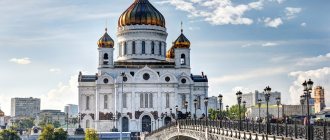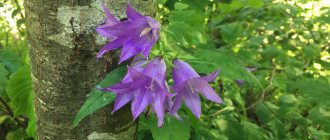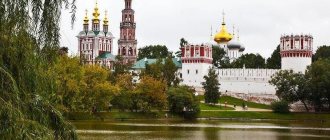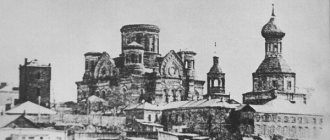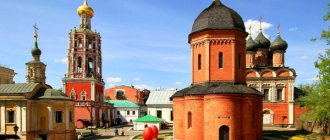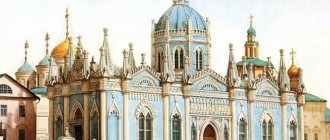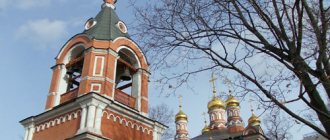A little history
According to historians, the Monk David belonged to the princely family of Vyazemsky. His real name is Daniel. At the age of twenty, he decided to go to the Pafnutievo-Borovskoy monastery, where he lived for more than twenty years.
In 1515, David founded the monastery, now known as the Ascension David's Hermitage.
During the reign of Ivan the Terrible, the construction of a large stone Church of the Ascension of the Lord began. But it was not destined to be completed. There are objective reasons for this. Initially, the monastery and its territory were attacked by Lithuanians and Circassians, who burned and destroyed many valuables, destroyed pre-existing buildings and plundered all supplies. By order of Patriarch Joachim, the temple was completely dismantled. Joachim ordered the construction of a new temple in its place. The stone church grew over David's tomb. Previously, there was a wooden chapel on this site. Its size was not too large.
At the very end of the 17th century, another chapel was built on the territory of the monastery, next to the Arbat Gate. It existed for a little over a century. Then, in its place, a monastery courtyard was built.
Until the middle of the 18th century, the Holy Ascension David's Hermitage belonged to various monasteries. The main reason for this situation is low incomes. Pustyn owned several poor estates that brought in very little money. There were not enough funds at all - even to maintain churches and monastic brethren. In 1765, a chapel located at the Moskvoretsky Gate was added to the desert. Previously, it belonged to the Morchugovskaya Hermitage, which ceased to exist. In this chapel there was an icon of the All-Merciful Savior.
At the same time, the Davidova Hermitage received another chapel, which was located at the Kaluga outpost. At the end of the 18th century, housing was built in the monastery for the significantly increased brethren. By the beginning of the 20th century, about a hundred monks lived there. Among them was Alexy, who at one time predicted the end of the Sevastopol War.
desert base
David came to the site of the future monastic monastery just 6 years after this territory was liberated from the rule of the Lithuanians.
Previously, it was part of Lithuania, but the prince who owned this land became subordinate to Moscow in 1509. The Lithuanians, of course, did not want to give up a large piece of land so easily; they constantly fought for it. This area was often ravaged, and its inhabitants demanded not only spiritual help, but also material care from the monastery brethren.
This is interesting! What prayers should be read before confession and communion.
With the activities of Rev. David is associated not only with the construction of monastery churches and other buildings, but also with the planting of a linden alley outside the desert fence. Tradition says that the monk brought linden trees from a nearby forest and planted them with their roots up not far from the monastery. He did this in full view of the monastery brethren and surrounding residents, so that they would be confirmed in the faith. A miracle took place according to the will of the Lord, and the trees took root.
Parishioners gave donations to the monastery and brought the fruits of their labors. The inhabitants of the monastery also worked incessantly. Barrels of cucumbers and various pickles were lowered into those reservoirs and ponds that were located on the territory of the monastery. And in the winter, all this was distributed to those in need, to those who came asking for help. The monastery always shared with people everything it had, leaving no one hungry. Saint David was popularly called the father-breadwinner.
This is interesting! What does the Kykkos Icon of the Mother of God in Cyprus help with?
The arduous body of the Rev. was laid to rest.
David on September 19, 1529. Shortly before his death, the saint was visited by the lamp of the Orthodox faith, Joseph Volotsky. This meeting is depicted on the wall frescoes of one of the monastery churches. A modest wooden chapel, built over the saint’s grave, reminded everyone of eternity. Now over the relics of St. David of Serpukhov and Lopasnensky stands a stone temple dedicated to one of the most revered icons in Rus', “The Sign”.
Seventeenth century
David's Ascension Hermitage was well known to the Russian tsars and their households, who never left the monastery with their mercy. Tsar Ivan Vasilyevich the Terrible himself especially loved the Ascension Hermitage. He even used his own personal funds to begin the construction of the first stone cathedral in honor of the Ascension of the Lord, without taking a penny from the treasury for this. I have heard about the exploits of the Rev. David, the king issued a charter to the monastery for ownership of estates, fishing grounds, and various lands. It was the heyday of the desert.
Together with all of Russia, the monastery experienced the timelessness of the Great Troubles and its consequences. Miraculously surviving in 1612, it was completely ruined and devastated by the dashing little people of Ataman P. Sagaidachny. His detachment, consisting of Zaporozhye Cossacks and Lithuanians, then plundered many churches and monasteries in Muscovy.
A few years later, the tsar renewed the charter and benefits granted to the monastery by Ivan the Terrible. And the monastery began to come to life, to rise from the ruins and ashes. The desert blossomed, and the surrounding villages blossomed. It was not ignorant men and women who came to the monastery churches, but literate people versed in the Holy Scriptures and liturgy, who were enlightened and taught by the monks.
Eighteenth century
The 18th century was coming, which for some reason is called the time of enlightenment and humanism. However, this time became the most difficult test for the entire Orthodox Church, and especially for its spiritual strongholds - the holy monasteries.
It is important! Saint Alexander of Svirsky: the life of the great elder.
Peter 1 really did not like monks, because he considered them idlenesses, parasites.
He also issued a decree according to which only disabled people, cripples and old people could go to the monastery. This fight against monasticism was started by his father, Alexei Mikhailovich (Quiet). Peter 1 was an active successor of his work, became an unstoppable fighter against the church, so he could not perceive the Orthodox spirit in any way. The Monastery and the Ascension David's Hermitage were subjected to all sorts of troubles:
- periodically lost independence,
- was assigned to other monasteries,
- was deprived of content.
As a result, the monastery was ruined even worse than in the Time of Troubles. But precisely at this time, by some miracle, over the coffin of St. Instead of a wooden chapel, a stone bell tower was built thanks to the efforts of benefactors of the monastery.
Nineteenth century
The most fertile time for the Holy Ascension Hermitage was associated with Metropolitan Platon of Krutitsky and Kolomna. The saint was a zealous admirer of St. David and a supporter of strict monastic life. A new order of worship and life was established at the monastery, which immediately affected the spiritual growth of the brethren.
But 1917 struck. A dark time for all of Russia. Many churches and monasteries were destroyed with such cruelty, as if they wanted to erase from the face of the earth all the people’s memory of their ancestors, their faith and their heritage. The monastery went through a terrible time - complete desolation and destruction. And it seemed that the monastery would never be revived for monastic life.
But in 1992, the pendulum of history swung in the opposite direction. Residents of the village of Novy Byt (Chekhov District) formed an Orthodox community, and the authorities transferred the cathedrals and temples of the monastery to it. The monks returned to the monastery. In the Znamensky Church over the relics of St. David, buried under a bushel, the first roses appeared. This was the beginning of the revival of the Ascension David Hermitage.
David's Hermitage in the 19th century
The beginning of the 19th century was marked by a noticeable improvement in the condition of the monastery. The Church of St. Nicholas, in a terrible state, was completely dismantled and rebuilt. Many new small outbuildings have appeared.
The iconostasis in the Church of the Ascension of the Lord has been completely renewed. By the middle of the century, the Znamensky Church was rebuilt, and the old bell tower was restored. A bell was cast for her, the weight of which exceeded 205 pounds.
The end of the 19th century was marked by the opening of a men's parish school. The construction of the Cathedral of the All-Merciful Savior dates back to the beginning of 1900.
Monastery during the Soviet years
Like dozens of monasteries in the Moscow region, the Ascension Monastery of David's Monastery was closed in 1929. An agricultural technical school operated here, and dormitories for students were organized in the premises where monks had previously lived.
The new government turned ancient temples into garages and warehouses. St. Nicholas Church became a gathering place for atheistic societies. Anti-religious debates and discos began to be held here.
The Assumption Cathedral turned into a sports hall. A red banner was hoisted onto the bell tower. The holy graves were excavated and the tombstones were used as the foundation for a new dormitory. The monastery fence was completely destroyed, as were the domes on the temples.
Holy Ascension Monastery: recent history
David's desert was in complete desolation until 1992. At this time, they began to raise funds for the restoration of the holy place. The monastery got a rector in 1995. Hieromonk Herman took this place. Before that, he served as rector of the Intercession Church.
First of all, he began preparing the cathedrals for a full daily cycle of services, since in those days the liturgy was not celebrated. With two novices, the abbot began to prepare one temple.
In 1995, the first liturgy was held in the monastery. Soon a long-awaited event occurred - on June 1 of the same year, the decision of the Holy Synod was announced that monastic life would be resumed in the desert, and Herman received the rank of abbot, and he was given the abbot's staff.
In 1996, the Istomin couple donated a belfry of seven bells to the monastery. It was consecrated by Bishop Juvenal.
In the winter of 1997, restoration work began in the desert. In 1998, a bell that weighs a ton was donated to the monastery. It was installed on June 5th.
In 1999, the domes of cathedrals and churches were completely restored, and the Znamenskaya Church was consecrated. In 2003, the Ascension Cathedral was consecrated. The iconostasis has been completely restored.
The relics of St. David were transferred to the Znamensky Church, and then restoration work began.
At the same time, more than two hundred fragments of the relics of God's saints were collected in the monastery. Particles of the Robe of the Virgin Mary and a nail from Christ's crucifixion are kept in the desert. By the end of 1999, the interior decoration, cathedral domes, pond and fence of the monastery were restored.
Life today
Today services continue as usual, pious pilgrims arrive, and monks carry out obediences. The monastery is managed by Abbot Sergius. Since becoming rector in 2011, he has already done extensive work. For example, to prepare the entrusted monastery for the celebration of the 500th anniversary of its founding. The holiday was celebrated in 2015, and a tremendous amount of work was done to prepare for it. In addition to this extensive holiday, 2015 was remembered for the fact that the monastery celebrated the 20th anniversary of the revival of monasticism in it. The schedule of services in David's Desert is presented below.
Monastery today
When approaching the village of Novy Byt, around one of the turns, a magnificent view will open up in front of you. From this place, the Holy Ascension David's Hermitage is perfectly visible - the entire architectural ensemble and its residential buildings.
After 63 years of desolation, the monastery came to life. The Cathedral of the All-Merciful Savior was transferred to the Orthodox community organized in the village of Novy Byt.
The Monastery of David's Hermitage was not restored easily. The abbot of the monastery faced a lot of problems, but did not give up on his goal. In 1995, Father German was brutally murdered. According to the official version, the crime was committed for the sake of profit - the monastery safe was robbed.
The magnificent restoration of the monastery is overshadowed by various rumors that shroud the process. The clergy are accused of accepting large donations for the restoration of the monastery from people with dubious reputations. This is Gennady Nedoseka and Anton Malevsky. Today in the monastery cemetery you can see their graves, which differ from other burials in their luxury. Malevsky is the former Russian “aluminum king” and the leader of the Izmailovo criminal group, Nedoseka is an employee of the administration of the city of Chekhov, with a very dubious reputation. Despite everything, thanks to the help of these, not the most righteous, people, David’s deserts were restored.
Modern life of the monastery
Already at the entrance to the monastery, a unique picture opens up:
- There are several colorful churches in a row with a beautiful golden-domed bell tower. Today thousands of pilgrims come to the monastery to venerate the relics of the saint.
- Liturgies are celebrated here every day, children are raised, the village kindergarten is cared for, and a lot of social work is carried out in the parish.
- The monks of the monastery carry the word of God through an art school, an orphanage, a secondary school, and a technical school.
- Hegumen of the monastery Sergius pays great attention to social work, and first of all, to supporting the younger generation.
- Monks help low-income families, orphanage graduates who are starting young families.
Father Sergius and the brethren of the monastery do a lot in matters of moral education of the younger generation. The monastics renovated the kindergarten. Father Sergius is present at all children's parties and communicates closely with the children. The Sunday school located in the monastery is constantly attended by up to 25 children. They develop here, in which they are ahead of their peers from secondary schools.
Attention! You can find out the address of the monastery, its description and photo, and the schedule of services by going to the official monastery website on the Internet.
Desert Tour
You can enter the monastery through the Holy Gate. The gate bell tower rises above the entrance. Its height is more than 70 m.
You will see an unusually well-groomed, clean area. There is also a small but very picturesque pond here. The sparkling church domes are reflected on its mirror surface. This place is very different from other monasteries. Look at the photo. The Voznesenskaya Davidova Hermitage is built up with buildings that are painted in warm, but at the same time rich colors (orange, yellow, pink).
Basic buildings of the desert:
- Assumption Gate Church.
- Znamenskaya Church.
- All Saints Refectory Church.
- Cathedral of the All-Merciful Savior.
- Znamenskaya Church.
- Church of St. Nicholas the Wonderworker.
- Ascension five-domed temple.
The walls of the Znamenskaya Church are painted orange, St. Nicholas Church - yellow. The Ascension Cathedral captivates with its whiteness, the Assumption Church attracts with its delicate pink-beige hue.
They were built at different times, but in a surprising way they combine very harmoniously with each other. In addition, there is a monastery cemetery in the desert. Not only monks are buried here. For example, D. S. Dokhturov, a hero of the Russian-French war (1812), rests in the churchyard.
Today there are 12 inhabitants in the monastery. Its rector is Abbot Sergius (Kuksov). Every day a liturgy is held at the monastery.
Znamenskaya Church
Before the October Revolution, there was a coffin with the relics of Moses Ugrin in this temple. He was brought to the monastery by the Metropolitan of Moscow, Platon. Unfortunately, it has not survived to this day. The main attraction of the church is the ancient icon of the Blessed Virgin Mary. The Monk David came with her to the desert, and here he found his rest.
In addition to the miraculous icon, many shrines are kept here. To the left of the altar is a carved shrine containing the relics of David. According to the inhabitants of the desert, after the death of the monk, he began to come to people in dreams and heal them.
To the left of the entrance is kept the head of a baby from Bethlehem (one of the 14 thousand killed by the Decree of King Herod), particles of the relics of Sergius of Radonezh.
Holy spring
Not far from the holy monastery, in the small village of Talezh, there is his farmstead. This place was made famous by a unique source. David's Hermitage, according to believers, is a truly unique place. The mentioned spring was consecrated in the name of St. David. For hundreds of years, it quenched the thirst of pilgrims. Orthodox Christians came here from all corners of the Russian land to drink the life-giving moisture. It was consecrated by the prayers of David, who went to this source on foot from the desert. In the courtyard there is a temple of the monk, there are baths. Everyone who has visited this place leaves here peaceful, with a particle of God’s grace in their soul.
Davidova Hermitage: how to get there
To visit this holy place, you can use a personal car or public transport. Many pilgrims dream of coming to these places and seeing with their own eyes what the David’s Hermitage (monastery) is like. We will tell you how to get here. To do this, you need to take the train coming from the Kursk station and drive to the Chekhov station. Then you need to take bus number 36 and get to the village of Novy Byt.
This route can also be covered by intercity bus, which follows the route “Moscow–Nerastnoye”. In addition, the village can be reached from the Yuzhnaya metro station.
If you are planning to travel by car, then you will need to drive along the Simferopol highway, until it intersects with A-108, turn left (to Kashira), then follow the signs.
If you are planning to visit David's hermitage, then you need to know that you must be dressed appropriately: the woman's head must be covered with a scarf. Men in “beach look” will not be allowed into the monastery.
Information for pilgrims and tourists
David's Hermitage is open on weekdays from 7:30, on weekends from 6:00, and closes after the end of the evening service.
The church shop is open from 9:00 to 18:00 every day: here you can buy candles, icons, literature, audio and video materials about the monastery, as well as order commemorations. Shop phone number: 8 (495) 996-0745, 8 (49672) 41652.
How to get there
There are different ways to get to David's Desert. You can get there from Chekhov on your own: to do this, you need to take a bus at the bus station and get to the “Novy Byt” stop. The following routes will be required:
- No. 36: runs every hour to the “NATI” stop in the village of Novy Byt;
- No. 36K: runs every 4 hours to the “Red Eagles” stop in the village of the same name;
Important: at the “Red Eagles” stop there is St. George’s Chapel.
From Stupino bus station there is bus number 46. He goes every 5 hours.
from Moscow in 3 ways:
- By train from Kursky station to Chekhov (station of the same name) and then by the above buses;
- From the bus station to the Yuzhnaya metro station by bus No. 428 - it goes to Chekhov every 5 hours;
- By car you will need to drive along the Simferopol highway (M-2) or the Moscow-Don highway (M-4) to the A-108 highway. From there, turn onto Molodezhnaya Street – there is a sign on it to David’s Hermitage.
Where to stay
You can stay in Chekhov: there are several hotels near the bus station:
- First : This hotel only has one bed, but is within walking distance of the station and bus terminal. There is a laundry service, several shops and cafes are located nearby, and the Chekhov Museum is located nearby. The cost of the night is about 2.5 thousand rubles.
Address: Chekhov street, building 4A, apt. 34;
- Hostel "Chekhov" : it has everything a guest needs - internet, parking, swimming pool, sauna, paid transfer from and to Domodedovo airport. It offers several private rooms and dormitories, and 24-hour reception. The cost starts from 550 rubles per day.
Address: Vesennyaya street, building 26A;
- Hotel "Olympiyskaya" : business hotel has 3 stars and is suitable for people with disabilities (in wheelchairs). Guests have access to the Internet, dry cleaning, laundry, gym, and parking. Room rates start from 3 thousand rubles.
Address: Sovetskaya Square, building 2; phone: +7 (4967) 26-90-48, -50.
Also in Chekhov you can stay at the Chekhov Prestige, Rodnik, and Russkoe Pole , but, as reviews show, they are much further from the station. “Peshkov’s Estate” in the village of the same name is a holiday home where you can stay for a long time.
Excursions
All excursion programs are carried out by prior agreement and order.
This can be done by calling 8-909-685-81-44 and 8-926-886-36-35, Elena Gennadievna handles orders. Walks are held from 11 a.m. to 3 p.m.; photography and video shooting are possible only with the approval of the abbot. The minimum cost of the excursion is 500 rubles, the minimum group is 6 people. If the group is more than 10 people, the ticket price for an adult is 50 rubles, for a child or pensioner - 30 rubles. If the group has its own guide who is not a representative of David’s Hermitage, the ticket price will be 30 rubles.
This is interesting : the prices indicated are not exact - these are donations that can be changed at the request of pilgrims, but it is not advisable to reduce them.
It is possible to organize a meal, its cost will be 250 rubles per person (200 rubles per child under 10 years old). You will need to confirm your meal the day before arrival, otherwise your order will be cancelled.
Schedule of services
On all days except Sunday, the schedule is as follows:
- 8:00 – Divine Liturgy;
- 17:00 – Evening worship.
On Sunday the schedule changes:
- 6:30 – early Divine Liturgy;
- 9:00 – late Divine Liturgy;
- 17:00 – Evening worship.
The main holidays of the David Desert are associated with the discovery of the relics of saints. The main holidays are considered to be memorable dates associated with the Monk David, the founder of the monastery - October 2 and 31, May 23 (discovery of relics). Other memorable dates are associated with holy holidays (Christmas, Ascension, Easter, etc.), saints' days and the laying on of relics.
Take note: one saint may have several memorable dates: for example, they “celebrate” the dates of the acquisition of the Cross and Nails, the Exaltation and carrying out of the Cross.
Davidova Pustyn is located 23 km from Serpukhov and 60 km from Moscow. This is a majestic complex of Orthodox churches and monasteries, which contain the relics of more than 200 shrines.
For more information about the monastery, watch the following video:
Reviews from guests of the monastery
The restored and restored Holy Ascension David's Hermitage does not leave anyone indifferent. Most guests of the monastery are delighted with how carefully and reverently they treat ancient church relics in the desert, and how the monastery Charter is revered. Many emphasize the friendliness of the clergy, who speak lovingly about the monastery and its history.
However, there are also negative reviews. As a rule, they are associated with the use of “unrighteous” money during the restoration of the monastery and the burial on its territory of people who at one time had problems with the law. It must be said that ordinary parishioners, pilgrims, and residents of nearby settlements also took part in the restoration of the desert (in addition to the indicated persons).
Be that as it may, David’s Hermitage (reviews from visitors confirm these words) is a unique monument of history and architecture of our country. Therefore, we recommend that you definitely visit this monastery.
For pilgrims
The schedule of David's Desert services is given above. You must arrive early for services without being late. To light candles and venerate relics and icons without fuss. Women must enter the monastery in skirts and scarves. Men wear trousers.
It is worth remembering that the services in the David’s Hermitage are long, according to the monastic charter. Therefore, it is advisable to think about comfortable shoes.
